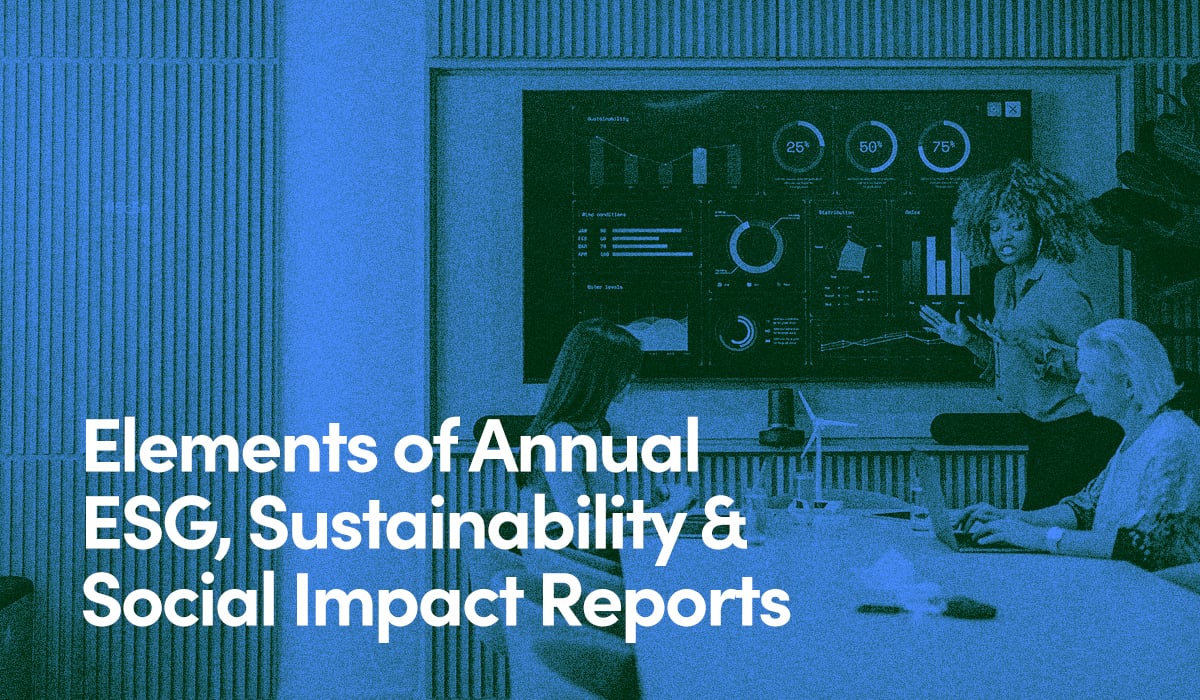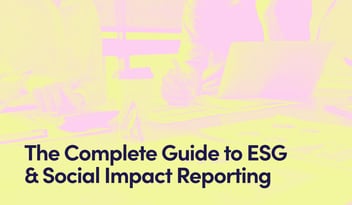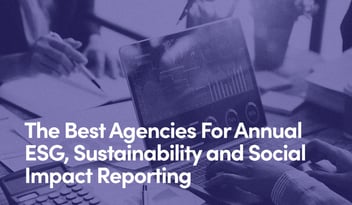Elements of Annual ESG, Sustainability & Social Impact Reports

Shareholders, consumers, investors, and business leaders have grown increasingly concerned with the impact their organizations have on the world. This newfound focus on environmental stewardship and sustainability, social responsibility, and corporate governance is anchored by annual reports outlining progress and identifying areas for improvement.
Also known as social impact reporting, this has become a must for organizations seeking to be more transparent about their efforts regarding many environmental, social, and economic causes—or under investor or regulatory pressure to do so. This includes everything from climate change, deforestation, and carbon footprints, to gender equity, worker conditions, and human rights, among others.
It’s becoming hard to thrive in any industry without investing in impact reporting infrastructure and initiatives, as reputations depend on it more and more.
For instance, 96% of S&P companies published sustainability reports in 2022, according to Governance and Accountability Institute, an ESG and sustainability consulting firm based in New York.
So what are social impact reports exactly?
What Is an Annual ESG Report?
Incorporating environmental, social, and governance (ESG) reporting is no longer simply a voluntary initiative, but increasingly mandated by governments and desired by consumers and investors.
Annual ESG reports entail all of the impacts an organization’s operations have across three key areas:
- Environment: Using various reporting frameworks to better understand and, if necessary, change behaviors regarding your environmental impact. Depending on your organization, this can range from improving energy efficiencies and using more climate-friendly industrial products or packaging to reducing your overall carbon footprint or better protecting natural habitats.
- Social: While the “social” aspect of ESG is incredibly broad, it can cover everything from the way in which you treat your employees, third-party suppliers and DEI practices, to investing in historically marginalized communities and improving your overall standards.
- Governance: While sometimes overshadowed by your environmental and social impact, governance is hugely important because the extent to which you’re successful in creating a more healthy, safe, and equitable organization requires buy-in from people in leadership positions. Some questions to consider: Are your leaders held accountable? What forms of democratic processes are in place? Is your organization, as a whole, accountable to the communities you impact?
Consumers want to be sure the money they spend on products goes toward brands that care about more than just the bottom line.
But impact reporting is not only for the benefit of consumers. Shareholders demand annual ESG reports because they, likewise, want to ensure their dollars are going to more conscientious brands and organizations. ESG reports help them more easily determine who is an ethical investment, and who is not.
It’s also about reputation. As it’s said, reputations take a lifetime to build and only moments to destroy. Utilizing annual ESG reports helps organizations avoid involvement with negligent, dishonest, or unethical entities.
As you can imagine, impact reporting has become especially important to publicly traded companies, although small to medium-sized businesses are following suit. It’s also worth noting that ESG, or elements of such reporting, is becoming increasingly mandatory.
Put simply, ESG reporting is about shedding light on your organization’s activities so that others can evaluate your impact on the world.
Elements of an ESG or Social Impact Report
While there currently isn’t a universally accepted framework for ESG reporting, you’ll find several common features. These will include both quantitative and qualitative data regarding each of the three major areas of social impact reporting.
Internal Data
For environmental stewardship & sustainability, you might include how you’re addressing climate change, reducing carbon emissions, shortening supply chains, properly managing waste, utilizing recycled and renewable materials, improving water and air quality, and fostering biodiversity.
For social responsibility, you might outline your compliance with labor standards and other human rights benchmarks, demographic make-up of employees including members of marginalized and protected groups (LGBTQ+, racial minorities, disabled professionals, etc.), and what you’re doing to advance the quality of life for not just employees but the communities you interact with.
For corporate governance, you’ll focus on making the internal workings of your organization transparent, including all political contributions, board composition and decisions, compensation for c-suite and executives, audit of committee structure, principles and processes that guide organizational decision-making, shareholder influence, and have no issues with bribery or lobbying.
ESG Scoring
In addition to all the internal data you gather about your organization, impact scoring also includes an ESG score, typically assigned by a third-party group reputable in ESG. Among the companies that provide ESG scoring, you’ll find organizations such as Bloomberg ESG Data Services, RepRisk, Dow Jones Sustainability Index Family, Sustainalytics ESG Risk Ratings, Greenly, Moody’s Investors Service, and Ecolytics, to name a few.
These scores are intended to transparently evaluate your long-term ESG performance against industry standards for compliance, including hundreds of metrics. Naturally, having an ESG score higher than your peers will bode well for your future investment and longstanding revenue.
ESG Frameworks & Standards
Truth be told, there are more than a dozen standards, guidelines, and frameworks used to conduct impact reporting. Your situation will dictate which is right for your organization.
Here are a few of them:
The Global Reporting Initiative (GRI) and International Standards Organization (ISO), for example, are both industry-agnostic standards intended for multiple stakeholder groups. GRI reveals the negative and positive effects your organization has regarding ESG, while ISO determines risks and process recommendations to improve your ESG score.
Alternatively, Sustainable Development Goals (SDGs) are industry-agnostic guidelines established by the United Nations (UN) in 2015, designed as a blueprint for global progress across nearly any category you can imagine. Industry-leading, customer relationship management software provider Salesforce, for example, has made SDGs core to their operations.
You’ll also find industry-specific frameworks and standards, as well.
Principles of Responsible Investment (UNPRI), for instance, is a framework for financial investors who want to increase their returns responsibly, while minimizing risk.
Why Do Annual ESG, Sustainability & Social Impact Reporting?
Implementing annual impact reports will make you more appealing to investors and for partnerships, attract more clients and customers, and inform other shareholders. However, there are a few more things these types of reports offer organizations, especially small to medium-sized companies.
ESG reporting gives you a clear picture of areas in which you can improve. When a third-party provides an ESG score, you can have confidence you’re receiving a more objective and less biased assessment of how well you're doing regarding environmental impact, social issues, and governance. Since they’re done externally, you’re more likely to minimize the assessment biases held by internal team members.
You don’t know what you don’t know, but employing a third-party ESG vendor can help overcome that.
As an organization, you should already have a solid grasp of your vision and mission, but without implementing annual social impact reporting, you miss out on a key process for determining how well you are achieving your goals and actualizing your purpose.
In other words, it’s another way to stay centered on the values that animate your organization and matter to the communities you work in. And as a result, potential clients, customers, and shareholders will reward you for it.



